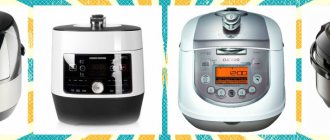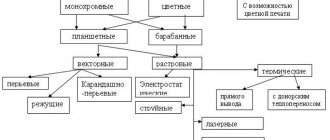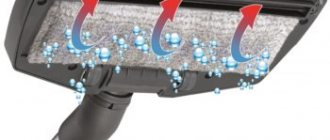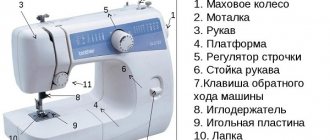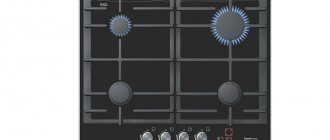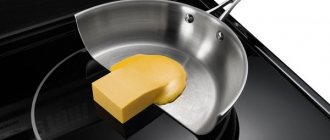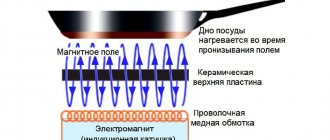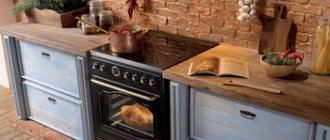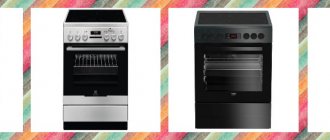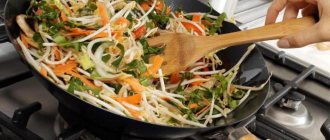When choosing an electric stove, the consumer takes into account many characteristics and operating nuances. The power, dimensions of the equipment, and functionality come to the fore. It is difficult to overestimate the importance of these criteria when using the stove, but there are also fundamentally important selection criteria on which the quality of the cooking process and the safety of equipment operation depend. These parameters also include the type of burner. This characteristic has become especially relevant against the backdrop of the emergence of stoves equipped with glass-ceramic surfaces. When familiarizing themselves with such models, many housewives discover Hi Light burners for the first time. What they are and what their peculiarity is are quite logical questions, which a general overview of this part of the electric stove will allow you to understand. It often happens that the emergence of innovative technologies overshadows all the advantages of traditional devices. In order not to make a mistake when switching to new equipment, it is worth assessing the features and capabilities of different burners.
Rapid burners
On such a surface you can see red-hot high-temperature spirals. The heating process takes an average of 10 seconds, which ensures convenient cooking. Rapid-type burners are present in the model lines of almost all manufacturers. Versions of stoves differ in the shape of the working surface and power. By the way, there are rapid burners for electric stoves with an expandable heating zone, as well as those made in a traditional round shape. Thanks to this approach, the owner of the stove will be able to cook in any vessel without thinking about uneven heating and wasted energy consumption. In burners with a diameter of about 21 cm, the power is usually 2.1 kW, and options for 14.5 cm provide heating with a power of 1.2 kW. The advantages of such models include their efficiency in heating large dishes, for example, if you need to cook a large pot of soup or cook a lot of vegetables at the same time.
Halogen cooking surfaces
The heating process in this case is ensured by a high-temperature spiral, which is combined with a halogen lamp - hence this burner got its name. This type of stove is equipped with a gas-filled quartz tube, which is involved in heating the cookware. Such surfaces can also be distinguished by the characteristic glow of a bright red lamp, which emits more and more heat as it glows.
The advantages of a halogen surface include high power, fast heating and the same cooling. Such stoves reach their maximum power almost immediately after switching on, so you won’t have to wait long for the optimal temperature regime. Today, halogen type burners can be found in the model lines of manufacturers Bosch, Zanussi, etc.
Induction models
This is one of the latest technological developments, providing both high functionality of the plates and good ergonomics. The operating principle in this case is based on the interaction of an inductor and a powerful electric generator, which form an electromagnetic field. Thanks to changes in the directions of this field, induction burners for electric stoves provide rapid heating of dishes. In practice, you can notice another feature of such panels: they remain cold to the touch. This difference increases the safety of using induction cookers and makes operation convenient.
There is also an advantage in the form of savings, since energy is consumed exactly in the amount required to heat a particular cookware. The technology itself is quite complex, so such models can only be found in the lines of leading manufacturers. In particular, induction hobs are found in Electrolux, Siemens and Booster cookers.
Induction in the kitchen: safety first
Induction cooktops use electromagnetic coils as heating elements. The highlight of this solution is that it is not the glass-ceramic surface that heats up, but the cookware itself. Therefore, induction built-in hobs are the undisputed leaders in terms of safety.
You can sometimes find statements online that induction cookers do not provide uniform heating and it is difficult to simmer food on them. This is completely untrue. In terms of smoothness, efficiency and accuracy of heating intensity adjustment, induction hobs are not inferior to gas ones.
ADVANTAGES OF INDUCTION HOOKS:
- very high heating rate;
- energy efficiency at maximum - efficiency over 90%;
- surface heating temperature is not higher than 110 C;
- the risk of fire upon contact with a kitchen towel or other object is practically reduced to zero;
- high heating temperature of the dishes - you can cook even dishes that are very demanding in terms of heating level;
- instant reduction in heating intensity.
Like any technology, induction hobs have their own specifics. First of all, these are the requirements for dishes. It must be made of a ferromagnetic alloy or have a bottom with an insert made of such an alloy. On the other hand, the most affordable cookware - enamel - is also suitable. Checking pots for suitability is very simple: if a regular magnet “sticks”, the dishes can be used.
Unlike other types of heating elements, coils hum. They may be audible when operating at high power. When an electric current passes, they heat up somewhat, so the design of induction panels and cookers includes coolers (cooling fans), the operation of which can also be heard.
KEEP IN YOUR VIEW:
- Prices for induction built-in hobs are higher than other types of electric hobs.
- There are special requirements for dishes.
- Sometimes you can hear noise during operation.
All these features are more than compensated for by ease of use and energy savings.
Models with Hi Light technology
Burners of this type are distinguished by the fact that a tape made of a high-resistivity alloy is used as a working heating element. It is laid as the basis of the hob, the operation of which it ensures. The heating rate in this case is one of the highest - on average 5-6 seconds. A rational approach to heat distribution is also noted. The fact is that the radiation is distributed over the entire area of the Hi Light working area. Heating such a stove is quite efficient, but it also consumes a lot of energy. So, if a standard rapid surface requires 1.5 kW per hour, then in the case of Hi Light models it can consume up to 2 kW. Despite all the advantages, a complete transition to this technology has not yet been observed. That is, models in which all burners are implemented according to this principle are still rare. More often you can find stoves that provide a combined type of heating.
Popular models
Let's look at the most popular electric stoves with Hi Light burners. What are these models:
- Beko HIC 64403 TX is a typical representative of electric stoves with a belt heating type. There are 4 burners on the glass-ceramic surface, one of which is oval, which makes it easy to cook a dish in a long roasting pan, and the heating will be uniform. It has touch controls, a residual heat indicator and a child lock.
- Hansa BHC63906 - a feature of this model is automatic boiling. This means that first the burner heats up to the maximum value, and then the stove switches to the initially set mode.
- Miele KM 6230 - operating modes of the burners are set using the numeric keypad. The burners heat up very quickly (the manufacturer claims 35% faster than other companies). There is a function for using residual heat and the ability to set a minimum power level.
Combination burners
Perhaps the most technologically advanced type of modern electric stove is a combination of two types of burners - induction and Hi Light. The now familiar four-zone configuration includes two compartments that operate on the principle of an electromagnetic field, and two panels containing high-resistivity alloy tapes. In this case, the user can extract the maximum of useful qualities that Hi Light burners offer. What is this from the point of view of the owner of a combined model? First of all, the ability to quickly heat water, boil eggs and perform other operations that require fast and maximum heat transfer. If efficiency fades into the background, then you can switch to the induction burner function, which will provide ease of use with less energy consumption.
Types of heating elements of cooking surfaces
There are 4 types of burners: rapid, halogen, induction and Hi Light. Let's look at them in more detail.
Rapid burners are considered simple. Their heating element is a nichrome spiral. The hob heats up in about 12 seconds. Rapid burners have a round shape and different sizes. Electricity consumption is 1-1.5 kW/hour. Its value depends on the size of the burner.
Halogen hobs consist of a heating element in the form of a quartz gas-filled tube. You can start cooking on these burners in just 2 seconds. Electricity consumption is about 2 kW/hour.
Induction is an expensive, but at the same time the safest type of burner. Their advantage is that it is not the hob that heats up, but the bottom of the pan that sits on the stove. This reduces the risk of getting burned when cooking to a minimum. In addition, you can adjust the power as precisely as possible, which allows you to save energy. The disadvantage of induction burners is that you need to buy special cookware, and their price is too high.
It remains to find out what Hi Light burners mean. Let us consider this type of hob in as much detail as possible.
Disadvantages of Hi Light burners
Experts note two unpleasant moments that you should prepare for when purchasing a Hi Light electric stove. First of all, this is the lack of step adjustment. The surface operates at a given mode; fine adjustments are not provided. In other words, in terms of functionality, this option is significantly inferior even to outdated models. Another disadvantage that the Hi Light burner type has concerns savings. If we omit the high cost of the stoves themselves operating on this technology, then the demand for electricity will remain. It is for this reason that manufacturers are reluctant to develop this concept. However, if you need quick heating of food, reliability and durability, then this option is quite suitable.
Advantages and disadvantages
We will try to highlight the main pros and cons of the Hi Light burner.
- it takes a minimum of time to heat up the burner, so you can start cooking almost as quickly as on a gas stove;
- high heating speed helps to save energy, because cooking will take less time;
- short transition time from the hottest heating level to the minimum;
- It is practically not inferior in functionality to an induction hob, while it costs 2 times less;
- you don’t have to buy special cookware like for stoves with an induction heating element;
- The glass-ceramic surface is easily cleaned from plaque and dirt.
- the operation of the heating element directly depends on the network voltage;
- it takes some time for the burner to cool down after turning it off, unlike induction cookers, which cool down instantly;
- insufficiently high level of fire safety;
- high electricity consumption.
Reviews of Hi Light burners
It must be said right away that these burners are used by housewives who have appreciated all the advantages of glass-ceramic coatings; accordingly, the level of requirements for equipment in this category is quite high. So, the power of the stoves, ease of use, stylish appearance, ease of maintenance and reliability are noted. It is also worth noting the reviews that the combined Hi Light burners receive. What is this from a practical point of view? The combination of electromagnetic and electric heating allows you to get rid of the disadvantages of induction panels and the “gluttony” of Hi Light systems. According to the owners, the former cope better with the tasks of long-term cooking and stewing, while the latter are advisable to use for frying and heating.
Rapid burners or Hi Light - which is better?
It is these two types of heating elements of cooking surfaces that are most often subject to comparison. They are approximately in the same price range, but in terms of performance characteristics they differ somewhat. Let's consider the main parameters of these two types of hob elements and determine which is better: rapid burners or Hi Light. Let's start with the heating speed.
The time required to heat up a rapid-type hob is 12 seconds, while on a Hi Light hob you can start cooking in just 5 seconds. This is a significant advantage, especially when it comes to rushing to prepare breakfast or dinner for children.
The second criterion is the type of heating element. In rapid burners it is a spiral, and in Hi Light it is a tightly laid corrugated tape. In the second case, the useful heating area will be larger, and accordingly the speed and efficiency will be higher.
The third criterion is design. Hi Light burners are located under a glass-ceramic hob and look stylish and modern. When working, a thin red corrugated tape is visible through the glass of the working surface of the stove. The spiral of the rapid burner most often does not hide under the panel due to the heating rate not being high enough. As a result, the slab has an unaesthetic appearance.
How to choose the optimal model?
First you need to decide on the primary selection criteria. If power is at the forefront, then there will be no problems with the choice - high power potential today is characteristic of all types of hobs. Another thing is that peak power is not achieved immediately, and here the Hi Light burner type comes first, providing heating within 6 seconds. This option may also be of interest to those who appreciate the stylistic advantages of glass-ceramic panels, but are not prepared for the disadvantages of induction models. Other electric stoves should only be used due to financial limitations. Traditional stoves are cheaper, but in terms of ease of use and technical capabilities they are inferior to modern hobs.
